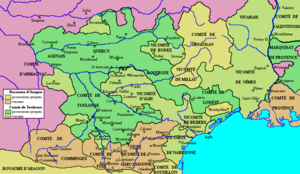Albigensian Crusade facts for kids
Quick facts for kids Albigensian Crusade |
|||||||
|---|---|---|---|---|---|---|---|
| Part of the Crusades | |||||||
 Massacre against the Albigensians by the Crusaders |
|||||||
|
|||||||
| Belligerents | |||||||
|
|
||||||
| Commanders and leaders | |||||||
|
|
||||||
| Casualties and losses | |||||||
| At least 200,000 to at most 1,000,000 Cathars killed | |||||||
| Considered by many historians to be an act of genocide against the Cathars, including the coiner of the word genocide himself Raphael Lemkin | |||||||
The Albigensian Crusade or Cathar Crusade was a long military campaign that lasted for 20 years (1209–1229). It was started by Pope Innocent III. The main goal was to stop the spread of a religious group called the Cathars. Their beliefs were different from the main Roman Catholic Church.
The crusade also aimed to make the Catholic Church the most powerful religious group in the area of Languedoc, which is in modern-day France. Most of the fighting was done by nobles from the Kingdom of France. The crusade led to a big decrease in the number of Cathars. It also changed the political map of Occitania, bringing it under the control of the French crown.
Contents
Who Were the Cathars?
The Cathars were a Christian religious group. They lived in parts of Europe, especially in Languedoc. They believed that there were two gods: one good and one evil. They thought the good god created spirits, and the evil god created the physical world.
This belief was very different from what the Catholic Church taught. The Catholic Church believed in only one God. Because of their different beliefs, the Catholic Church saw the Cathars as a "heresy." A heresy is a belief that goes against the official teachings of a religion.
Cathar Beliefs and Practices
Cathars lived a simple life. They often avoided meat and dairy products. They also did not believe in some Catholic sacraments, like baptism or communion.
They had their own leaders called "perfects." These perfects lived very strict lives. Many people in Languedoc, including nobles, supported the Cathars.
Why Did the Crusade Start?
The Catholic Church was worried about the growing number of Cathars. They saw them as a threat to their power and teachings. Pope Innocent III tried to get the Cathars to change their beliefs peacefully.
He sent preachers and missionaries to Languedoc. However, these efforts were not very successful. In 1208, a papal representative was killed. This event made the Pope decide to call for a military crusade.
The Pope's Call to Arms
Pope Innocent III asked Catholic knights and nobles to join the crusade. He promised them spiritual rewards for fighting. Many French nobles joined, hoping to gain land and power.
The King of France, Philip II of France, also saw an opportunity. He wanted to extend his control over the wealthy region of Languedoc. This region was largely independent at the time.
Key Events of the Crusade
The Albigensian Crusade lasted for two decades. It involved many battles and sieges. The crusaders often showed great cruelty towards the Cathars and their supporters.
Siege of Béziers (1209)
One of the first major events was the siege of Béziers. The crusader army attacked the city in July 1209. They killed almost everyone inside, regardless of their religious beliefs.
This event sent a strong message. It showed how brutal the crusade would be. Many towns surrendered quickly after hearing about Béziers.
Simon de Montfort's Leadership
Simon de Montfort became a key leader of the crusade. He was a skilled but ruthless military commander. He led many campaigns against Cathar strongholds.
Montfort gained control over large parts of Languedoc. He was given the lands of the defeated nobles. However, the local people often resisted his rule.
Resistance and French Royal Involvement
The local nobles, like Raymond VI of Toulouse, fought back. They sometimes allied with the King of Aragon. The fighting was fierce and long.
Later, the French kings, Louis VIII of France and then Louis IX of France, became more directly involved. This turned the crusade into a war of conquest for the French crown.
End of the Crusade and Its Impact
The Albigensian Crusade officially ended in 1229. This was with the Treaty of Paris. The treaty greatly reduced the power of the Count of Toulouse. It also brought Languedoc under the control of the French king.
The Inquisition
Even after the fighting stopped, the Catholic Church continued its efforts against the Cathars. They set up the Inquisition. This was a system to find and punish heretics.
The Inquisition used trials and sometimes torture. Its goal was to force Cathars to give up their beliefs. Many Cathars were executed or imprisoned.
Long-Term Effects
The Albigensian Crusade had a huge impact. It led to the decline of Catharism. The movement eventually disappeared. It also strengthened the power of the French monarchy.
The crusade also led to the destruction of much of the unique culture of Languedoc. It was a very violent period in European history.
Images for kids
-
This Pedro Berruguete work of the 15th century depicts a story of Saint Dominic and the Albigensians, in which the texts of each were cast into a fire, but only Saint Dominic's proved miraculously resistant to the flames.
-
Carcassonne with the Aude river in the foreground
See also
 In Spanish: Cruzada albigense para niños
In Spanish: Cruzada albigense para niños




